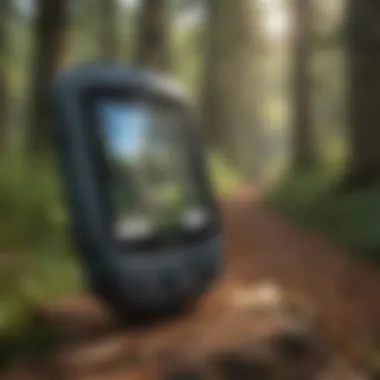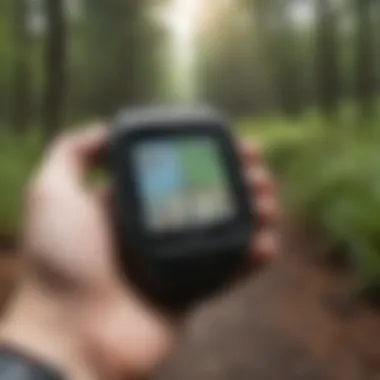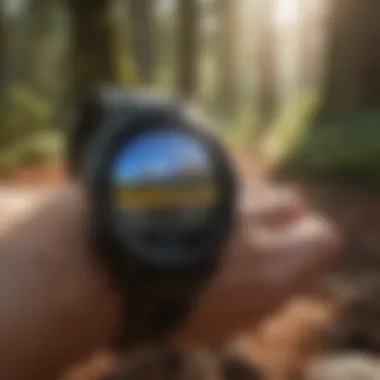Exploring the Garmin GPS III: Advanced Navigation Features


Intro
The evolution of navigation technology plays a crucial role in various sectors, notably in outdoor exploration, forestry management, and conservation efforts. The Garmin GPS III stands out as a highly sophisticated device in this transformation. As we investigate the essential features and applications of the Garmin GPS III, it is vital to understand its influence on woodland ecosystems and the practices that support sustainable forestry.
Understanding this device goes beyond examining its technical specifications. It involves acknowledging its impact on biodiversity and climate regulation and how it aids professionals in managing forest resources more effectively. This article will explore the interplay between Garmin GPS III functionalities and the best practices in forestry and conservation, offering insights valuable to professionals in these fields.
Intro to Garmin GPS
The Garmin GPS III holds a prominent position in the realm of outdoor navigation and resource management. Understanding its significance requires a closer look at how it integrates advanced technology with practical applications in varied landscapes. For outdoor enthusiasts, forestry professionals, and conservationists, effective navigation is crucial, and the Garmin GPS III serves as a reliable tool in this context. Its design and functionalities directly impact how users interact with natural environments.
Overview of GPS Technology
Global Positioning System (GPS) technology enables precise location tracking, utilizing a network of satellites orbiting the Earth. Each GPS device, including the Garmin GPS III, calculates its position based on signals received from these satellites. This process involves several complex interactions:
- Satellites: At least four satellites are needed for accurate positioning. They send signals that the device interprets to pinpoint location.
- Position Calculation: The device measures the time it takes for each signal to reach it, allowing it to triangulate its position.
- Application in Diverse Environments: This technology supports various applications, from hiking and boating to forestry management.
By leveraging GPS technology, the Garmin GPS III offers enhanced navigational support, particularly in landscapes that can be challenging to navigate.
Evolution of Garmin Products
Garmin began its journey in the early 1980s, focusing on aviation and marine navigation. As technology evolved, so did Garmin's product line. The GPS III is a testament to the company's adaptive strategies and innovations over the years. Key milestones in Garmin's evolution include:
- Introduction of handheld devices: Garmin released early handheld units that catered to outdoor adventurers. This accessibility broadened the user base.
- Integration of mapping technologies: Over the years, Garmin incorporated mapping functionality, allowing users to view detailed terrain data.
- Focus on user interface: As the need for intuitive design intensified, Garmin prioritized user-friendly interfaces, making navigation straightforward.
The transition from simple navigational tools to multifunctional devices illustrates Garmin's commitment to meeting user needs. Today, the Garmin GPS III stands as an embodiment of years of refinement and innovation, demonstrating how technological advancements can enhance outdoor experiences.
Technical Specifications of Garmin GPS
The technical specifications of the Garmin GPS III are crucial to understanding its capabilities. This device is designed to meet the needs of outdoor enthusiasts, forestry professionals, and conservationists. Its features are carefully crafted to optimize navigation and enhance usability. Several key elements highlight its benefits.
Display and Interface Design
The display of Garmin GPS III features a clear and intuitive user interface. The screen is sufficiently bright, allowing easy reading even in varying lighting conditions. Users can expect a straightforward layout that provides access to essential functions without excessive complication.
Having a responsive touchscreen is a vital aspect, as it enhances user interaction. The interface shows vital navigational information efficiently. Information such as coordinates, maps, and direction indicators appear in real-time, facilitating rapid decision-making in the field. For anyone operating in complex environments, such clarity is indispensable.
Battery Life and Power Considerations
Battery life is another significant aspect of the Garmin GPS III. The device can run for an extended time with minimal interruptions. Users can expect up to 30 hours of continuous use on a single set of AA batteries, which proves advantageous during long expeditions or forestry surveys.


To optimize power consumption, the Garmin GPS III incorporates features like automatic brightness adjustment. By minimizing unnecessary power drain, the device ensures reliability during critical operations. It is important for users to remember to check battery levels regularly to avoid challenges in remote areas where power sources may be unavailable.
Satellite Connectivity and Accuracy
Satellite connectivity is essential for accurate navigation. The Garmin GPS III provides robust connectivity by utilizing several global positioning satellite signals. This capability enhances the device's overall accuracy, allowing for precise tracking in various conditions.
Users can find peace of mind knowing the device maintains a strong satellite lock even in less-than-ideal conditions like dense forests. The accuracy of position data is within a few meters, which is critical for applications in forestry management and environmental research. Monitoring wildlife and surveying areas demands an exact location, and the Garmin GPS III delivers this reliability.
"The Garmin GPS III showcases technical specifications that directly influence usability, making it indispensable for professionals in the field."
Usability in Various Environments
The Garmin GPS III stands out in how it responds to diverse outdoor environments. Understanding its usability in various settings is vital for those who rely on accurate navigation. This section will discuss specific elements and benefits of the device, primarily focusing on outdoor navigation and its adaptability.
Best Practices for Outdoor Navigation
When using the Garmin GPS III, certain best practices enhance the experience. Firstly, always update the device's maps before heading out. This ensures access to the latest trails and routes. Secondly, following a planned route can significantly reduce navigation errors. Users can pre-load waypoints or routes which can later be easily accessed during outdoor activities.
Additionally, know the limitations of GPS technology. In dense woodland or mountainous areas, weak satellite signals may affect accuracy. Therefore, carrying a physical map as a backup is advisable. Users should also familiarize themselves with the device interface before actual navigation. This preparation allows for quick actions when in the field, reducing the chances of confusion.
Lastly, understanding how to mark and save waypoints can be helpful. When a user spots a key location, marking it ensures they can return to that point. This practice proves vital for those engaged in exploration or forestry management tasks.
Adaptability in Woodland Environments
Woodland environments pose unique challenges for navigation. However, the Garmin GPS III shows impressive adaptability. The device is designed to work efficiently, even in areas where signal may be obstructed. It provides feature that values accuracy in wooded locations.
Some important factors include:
- High Sensitivity Receiver: The Garmin GPS III includes a sensitive receiver which enhances tracking among tree cover. This is essential for operators needing specific coordinates in dense woods.
- Terrain Mapping: The ability to view elevations and terrain features aids users significantly. Understanding the topography is important in forestry applications.
- Continual Position Tracking: The device continually updates position even when satellite signals are blocke. This aspect is crucial for keeping track of one's movements in complex natural environments.
By implementing these adaptive features, the Garmin GPS III helps foster reliable navigation. This capability supports forest managers and outdoor enthusiasts as they conduct their activities in varied settings. Overall, the usability of the Garmin GPS III in diverse environments is crucial for effective navigation in both recreational and professional contexts.
Applications in Forestry Management
The role of Garmin GPS III in forestry management is pivotal. It provides tools that enable precise navigation, mapping, and data collection. These functionalities are essential for sustainable forest management, ensuring that forestry professionals can monitor and protect natural resources effectively.
Mapping and Surveying Forest Areas
Mapping and surveying wooded regions are critical in forestry management. Garmin GPS III allows for the accurate pinpointing of locations within dense forests. Users can create detailed maps by recording geographical coordinates that represent various features such as water sources, tree species, and terrain types.
This device offers high accuracy in positioning, which is vital for delimiting boundaries of protected areas or tracking changes in forest covers.
The detailed positioning capabilities of Garmin GPS III help in the analysis and planning of forest resources, making management more efficient.


Monitoring Wildlife and Biodiversity
Monitoring wildlife populations enhances our understanding of ecological balance within forests. The use of Garmin GPS III assists in tracking animal movements and identifying habitats. By integrating GPS technology with wildlife monitoring efforts, forestry specialists can gather data on species distribution and behavior patterns.
This data is invaluable for conservation efforts aimed at maintaining biodiversity. Utilizing the device in combination with software tools can also allow for more complex analyses, resulting in informed decisions that positively impact wildlife management strategies.
Enhancing Timber Harvesting Operations
Timber harvesting is another area where the Garmin GPS III excels. Accurate navigation reduces the risk of damaging surrounding flora during logging. By mapping out efficient routes for machinery, it minimizes environmental disruption.
Moreover, forestry managers can utilize the device to track timber supply chains, identifying felling areas and managing logistics effectively. This aspect of GPS technology enhances operational efficiency and optimizes resource management.
In summary, the Garmin GPS III is indispensable in various aspects of forestry management. Its practical applications in mapping, monitoring wildlife, and enhancing timber operations demonstrate its importance in promoting sustainable forestry practices. Each of these functionalities contributes to a broader goal of conservation and responsible management of forest resources.
Impact on Conservation Practices
Conservation is a critical field that seeks to protect natural ecosystems and biodiversity. The role of technology in this area cannot be understated. The Garmin GPS III has become a vital tool for professionals engaged in conservation practices. This section explores how this device directly influences conservation efforts, focusing on its applications in guiding restoration efforts and promoting sustainable practices.
Guiding Restoration Efforts
Restoration ecology is the scientific discipline that deals with recovering ecosystems that have been degraded, damaged, or destroyed. The Garmin GPS III offers precise navigation capabilities that help conservationists locate specific areas needing intervention. By using a robust satellite connectivity, it enables accurate mapping of habitats and assessment of ecological conditions.
Key benefits include:
- Accurate Mapping: The device allows for the creation of detailed maps that can identify rare or endangered species in a given area.
- Field Navigation: Professionals can easily navigate through challenging terrains, ensuring they can reach remote conservation areas efficiently.
- Data Collection: The GPS III aids in collecting spatial data essential for planning restoration efforts.
Utilizing Garmin GPS III for these tasks allows for smarter resource allocation. People can prioritize areas that require immediate restoration, maximizing conservation impact.
Promoting Sustainable Practices
Sustainability in conservation is about ensuring that natural resources are managed in a way that preserves them for future generations. The Garmin GPS III plays a role in promoting sustainable practices within forestry management and broader conservation strategies.
Some ways it contributes are:
- Tracking Changes: The device helps track forest health by monitoring growth patterns and identifying over-exploited areas.
- Efficient Resource Management: By providing accurate data on tree density and land use, Garmin GPS III enables better decision-making regarding resource allocation.
- Training and Education: It can serve as a training tool for new forestry professionals, helping to instill best practices from the start.
As conservationists integrate the Garmin GPS III into their daily operations, they reinforce the need for sustainable practices. The insights gained from its use contribute to creating strategies that protect ecosystems while allowing them to thrive. Ultimately, the impacts on conservation practices driven by technology like the Garmin GPS III cannot be overlooked. They are fundamental to addressing today’s environmental challenges and ensuring balanced ecosystems for the future.
User Experiences and Case Studies
User experiences and case studies provide valuable insights into the practical applications of the Garmin GPS III. Understanding how users interact with the device in real-world settings is crucial for evaluating its effectiveness and relevance. These elements not only highlight the strengths of the device but also reveal areas for improvement. Analyzing feedback from outdoor enthusiasts and professionals in forestry management lays the groundwork for enhancing the functionality of GPS technology in various environments.
Feedback from Outdoor Enthusiasts
Outdoor enthusiasts often rely on the Garmin GPS III for activities such as hiking, camping, and geocaching. The feedback from this user group is instrumental in assessing how well the device meets their navigation needs. Many users appreciate its user-friendly interface, which allows for quick access to essential features. The clear and high-resolution display is noted for being readable even in bright sunlight, which is a significant advantage during outdoor activities.


One area of consistent praise is the accuracy of the satellite connectivity. Users report that they can depend on the GPS III to provide accurate positioning, which is vital for safe navigation in unfamiliar terrains. The device's ability to maintain signal strength in wooded areas has been particularly beneficial for those who explore dense forests.
On the other hand, some users wish for improvements in battery life, especially during extended trips. While the device performs well under normal circumstances, there are instances where users have encountered issues with battery drainage. This feedback indicates that future iterations of the Garmin GPS III could benefit from enhanced energy efficiency, allowing for longer usage without the need for frequent recharges.
Case Studies in Forestry Management
The Garmin GPS III has also played a crucial role in forestry management. Case studies highlight its use in mapping, surveying, and monitoring forest conditions. For instance, forestry professionals have utilized the GPS III to create precise maps of timber stands, which assists in planning harvest operations. This capability not only streamlines operations but also contributes to sustainable forestry practices.
Professionals have also reported success in using the device for monitoring wildlife habitats. The accurate location data allows for effective tracking of species and assessing biodiversity within different forested areas. Such applications underscore the importance of the Garmin GPS III in supporting conservation efforts, facilitating a better understanding of ecological dynamics.
Despite its strengths, case studies reveal areas where the device can improve. Users have pointed out that while it excels in outdoor navigation, its data integration capabilities with other forestry management tools could be enhanced. Implementing more seamless data sharing could further augment its value in comprehensive ecological assessments.
Comparative Analysis with Other GPS Devices
A meaningful analysis of the Garmin GPS III against other GPS devices is essential. It provides insights into how its features and specifications hold up in a competitive landscape. Understanding these differences helps outdoor enthusiasts, forestry professionals, and conservationists make informed decisions on their navigation tools.
The outcomes of this analysis will highlight the Garmin GPS III's unique benefits, while also pointing out any concerns when compared to its counterparts.
Strengths of Garmin GPS
The Garmin GPS III stands out in various key areas. First, its accuracy is noteworthy. The GPS III utilizes multiple satellites for position triangulation. As a result, users can expect precise location data, especially in challenging outdoor environments.
Consider the display. The GPS III comes with a clear and intuitive interface. Users can easily access maps and data. This feature is especially critical during time-sensitive or emergency situations in the wilderness.
Moreover, the battery life of the Garmin GPS III is impressive. It can last a substantial amount of time on a single charge. This is a major advantage for those on extended expeditions where access to power is limited.
In terms of durability, the device is made to withstand harsh weather and rough handling. Outdoor professionals often work in demanding situations, and having a robust GPS device is crucial.
Finally, Garmin's software ecosystem is commendable. Users can find updates and additional functionalities easily, enhancing the overall user experience. Many GPS devices struggle with these aspects, making Garmin’s offering more favorable.
Limitations and Areas for Improvement
Despite its numerous strengths, the Garmin GPS III is not without its flaws. One noticeable limitation is its weight. Compared to some other lightweight GPS units, the GPS III might feel bulkier to carry during long hikes. This may be a concern for serious trekkers who prioritize weight in their gear choices.
Another area needing attention is the price point. The Garmin GPS III is positioned at a higher price range. This may deter some potential buyers, especially those who use GPS for casual navigation rather than professional applications.
Additionally, while it performs well in most environments, there are connectivity issues reported in heavily forested areas with dense canopies. The obstructions can interfere with satellite signals, although this is a common challenge across many GPS devices.
Finally, there is a learning curve associated with the device's features. New users may find the plethora of options overwhelming. Better onboarding resources could assist in bridging this gap and enhance early user experiences.
"The Garmin GPS III does excel in accuracy and battery life, but potential users should weigh its shortcomings carefully."
Epilogue: The Future of GPS Technology in Forestry and Conservation
The evolution of GPS technology will have profound implications for forestry and conservation efforts. Understanding how these advanced navigation systems operate is vital for those engaged in environmental management. As professionals in this field adopt tools like the Garmin GPS III, they revolutionize the ways they explore, monitor, and restore natural habitats.
Emerging Trends in Navigation
Recent advancements in navigation technology indicate a shift towards more sophisticated, user-friendly interfaces. Some notable trends include:
- Integration with Mobile Apps: More GPS devices are linking with smartphone applications to enhance functionality. These apps provide additional data analysis and visualization tools, essential for forestry professionals.
- Real-Time Data Sharing: Technologies that enable real-time data sharing can improve collaboration among teams. This capability is essential when managing large-scale conservation projects.
- Increased Accuracy with New Satellites: The deployment of additional satellites enhances location accuracy. Improved precision allows for better mapping of forest areas, which is crucial for effective management and conservation.
As these trends continue, the role of GPS devices like the Garmin GPS III will expand, allowing for more intricate and effective planning in forest management.
Final Thoughts on Garmin GPS Utility
The Garmin GPS III has established itself as a noteworthy tool within navigation technology. Its strengths in accuracy and durability make it particularly suitable for outdoor usage. Key benefits include:
- Enhanced Navigation in Remote Areas: Its ability to provide reliable signals in dense trees is a significant advantage for forestry applications.
- Support for Sustainable Practices: This device offers features that directly assist in data gathering, helping professionals monitor environmental health.
- User-Friendly Interface: The system's design accommodates users of various skill levels, providing a manageable learning curve.
"As technology advances, our ability to understand and interact with the environment likewise expands."
In a world where ecological concerns are growing, the future of GPS technology, especially within forestry and conservation, is not only promising but essential.







